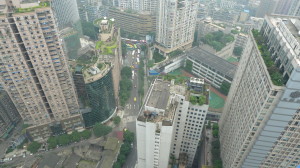 Most Europeans know little, or perhaps nothing, about this megalopolis in Southwest China. Until 1997 it was part of Sichuan province, thereafter it was separated from the province and began to emerge as the main hub for development amongst China’s western regions.
Most Europeans know little, or perhaps nothing, about this megalopolis in Southwest China. Until 1997 it was part of Sichuan province, thereafter it was separated from the province and began to emerge as the main hub for development amongst China’s western regions.
It is the youngest of the four municipalities under direct control of the central government in China, the others being Beijing, Shanghai, and Tianjin. Located at the confluence of the Yangtze and Jialing rivers it is the economic centre of the upper Yangtze and is a natural logistics and transportation hub. Ulrich O. Birch, Senior Consultant at Consenec Ltd and member of the Chamber’s board in Chengdu, takes a closer look at one of China’s three ‘ovens’.
With an area of 82,400 square kilometres, Chongqing Municipality is as big as Austria, or twice the size of the Netherlands. Of its 33 million inhabitants—about half France’s population—roughly one third live in the main city, one third in other urban areas, and one third in rural areas. However, it is subject to vast migration with around half a million people—equivalent to a sizeable European city—moving from the country to the city every year.
One of the chief architects of Chongqing’s development has been Huang Qifan. After driving development in Shanghai, he continued his efforts in Chongqing after becoming the municipality’s Mayor in January 2010. He is pragmatic, and has forged close ties to the local business community. In general the government is very business-oriented and cooperative at all levels. Due to its status as a municipality, Chongqing also enjoys a direct link to the central government in Beijing.
Its abundance of coal, natural gas, aluminium, strontium, manganese, and water make Chongqing a natural base for manufacturing, a sector that has increased its share to about 55 per cent in the last few years due to some major investments. However, the service sector is expanding fast and is a major focus for future development. It is also aiming to become a centre for the financial services industry.
Currently the main industries are automotive, motorcycles and parts, engines, power transformers, wind power, natural gas and chemical industry, steel and aluminium, IT and notebook computers, and home appliances. A major export hub, its total foreign trade volume in 2012 reached USD 50 billion, which ranks number 11 nationwide. Europe is its second largest recipient of exports after Asia.
 In 2010, the Liangjiang New Area was established, China’s third largest development zone behind Shanghai Pudong and Tianjin Binhai. It offers highly attractive incentives and simplified administration, as well as a bonded zone, which is bringing in an increasing number of domestic and foreign investors. Altogether, Chongqing has around forty development parks, all focussed on specific priorities.
In 2010, the Liangjiang New Area was established, China’s third largest development zone behind Shanghai Pudong and Tianjin Binhai. It offers highly attractive incentives and simplified administration, as well as a bonded zone, which is bringing in an increasing number of domestic and foreign investors. Altogether, Chongqing has around forty development parks, all focussed on specific priorities.
Already more than 220 of the global Fortune 500 companies have a presence here. Some major industrial or consumer goods companies such as 3M, ABB, Acer, Asus, BASF, Fiat, General Electric, Foxconn, Hewlett Packard, Ikea, Shell, and Volvo have all made a home in Chonqing. Development of five-star hotels is also booming; there are already close to 20 such hotels with another 14 under construction.
Foreign direct investment (FDI) increased about five times over the last 15 years and reached over USD 10 billion in 2011. The lower tax rates—15 per cent corporate income tax for qualifying companies, as part of the development policy in western China—is a major incentive bringing companies to Chongqing.
As Chongqing is one of the first regions to take advantage of the gradually opening skies for private aircrafts it is attracting some major aircraft manufacturers. The new regulations for low-altitude flights are offering opportunities for manufacturers and service companies in the domain of general aviation.
Logistically the municipality is well developed with about 120,000 kilometres of highways, 2,000 kilometres of railway and 4,300 kilometres of navigable waterways. It is linked to the capital, Chengdu, by a high-speed railway with another even faster railway under construction, which will reduce travel time to less than one hour.
It has two main civilian airports with two more being added. It boasts an increasing number of international air connections with the non-stop Finnair flight to Helsinki being the shortest hop to Europe. Opened in 2008, the Cuntan river port at the Yangtze is the biggest deep-water port in the western region, offering connections to the Yangtze delta as well as to international sea freight within five days.
Of course Chongqing has its share of challenges too. The issue of environmental pollution needs to be made a priority, and the huge strain that rapid industrial growth is putting on the electricity and water supplies also needs to be addressed.
Vocational and professional education needs to be upgraded and focussed more on the real needs of industry, and living conditions for foreigners have room for improvement too.
Certain areas of government would benefit from some oversight, and reducing the income disparity between the urban and rural population would be a welcome advance. This would also help to reduce the migration to urban areas which in turn would alleviate some pressure on existing urban infrastructure.
But although there is still much that needs to be done the commitment of municipal and district governments to the economic development of Chongqing, as well as their dedication to making general progress, inspires great confidence and indicates that Chongqing has a very bright future indeed.


Recent Comments